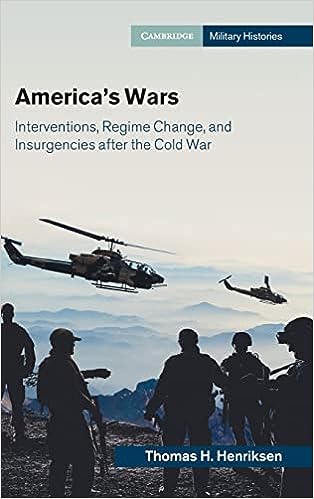The Book
America's Wars: Interventions, Regime Change, and Insurgencies after the Cold War
The Author(s)
Thomas H. Henriksen

The Cold War ended in 1989. More than three decades later, we are still trying to assess its impact on international politics and conflict. Put simply, its end ushered a rare period of unipolarity in world politics: the power of the United States was unmatched. Yet, the precise effects of this unusual unipolar moment are still debated. There is, perhaps, a good reason for this: these effects were ambiguous and contradictory. On the one hand unipolarity meant less conflict, since there was less need for proxy wars, the modal form of violent conflict during the Cold War. On the other hand, however, reduced great power interest in weak postcolonial states led to a rise of civil wars that festered in very weak or failed states—think Democratic Republic of Congo. To complicate things even more, these civil wars proved fertile ground for the growth of groups that felt aggrieved by the unipolar hegemony of the United States and decided to target it by using the method of transnational terrorism. Thomas H. Henriksen charts the subset of the post-Cold War conflicts that led to the direct military involvement of the United States. He proceeds chronologically and inductively and identifies two large categories of conflicts.
The first category includes a variety of conflicts that erupted in weak, divided, or failed states, mainly in the world’s periphery, and particularly those that led to highly visible, widespread humanitarian disasters. In turn, these disasters caused consternation and outrage in the West, thus prompting the undertaking of so-called “humanitarian” interventions that were characterized by both limited military scope and altruistic intent—what historian Walter McDougal called “Global Meliorism.” Not that self-interest was absent, but it was generally congruent with moral considerations: the idea was that assisting nation-building and facilitating democratization through military intervention was both a good thing in itself and a good for the United States’ long-term position in the world.
The second category is linked with the “War on Terror” and includes conflicts that followed the September 11, 2011, attacks and were somehow connected to the threat of terrorism emanating from a constellation of decentralized, transnational Islamist Salafist groups. With the exception of the major wars in Afghanistan and Iraq, most of the military action here took the form of light-footed military operations conducted in a shadowy way by special forces, from Yemen to the Philippines.
Henriksen provides a detailed and comprehensive overview of all these operations, including Operation “Just Cause” that overthrew the Panamanian strongman Manuel Noriega; Operation “Desert Storm” that rolled back Iraq’s invasion in Kuwait; and various operations in Somalia, Haiti, and the Balkans (Bosnia, first, and Kosovo later) linked with humanitarian agendas, up to the episode in Mogadishu, immortalized as “Black Hawk Down.” He then moves on to the post-2001 wars in Afghanistan and Iraq, and covers the host of smaller “counter-terror” operations in places such as the Philippines, Somalia, Yemen, and North Africa. The book provides robust coverage of Afghanistan and Syria before reaching the conclusion that this thirty-year period was most likely an interlude between the Cold War and the emergence of a new bi- or multipolar world that might well look and feel like the Cold War.
Overall, Henriksen heeds close to the ground. His account of the US military record during this period is readable, brisk, and concise. At the same time, he does not venture too much toward beyond the facts. I was left wondering about the larger stories. Is this all there is about? Will we forget this period as a low significance interlude? It would have been useful, I think, to reflect on the larger significance of this period. Is there a legacy that is likely to shape how the looming world order will look like? For instance, I would be inclined to argue that this thirty year period was decisive in that familiarized Americans again with war, reversing the isolationist effect of the Vietnam War and Operation Eagle Claw, the failed attempt to rescue the Iran hostages in 1980. I would also argue that an overview of this period reminds us that, in the middle term at least, history works in nonlinear ways. Osama Bin Laden observed America’s distaste for war in Somalia and concluded that a terrorist attack in the United States would cause it to move out of the Middle East. The opposite happened instead. Likewise, it was America’s experience in Iraq and Afghanistan that bred the ground on which the Islamic State insurgency emerged in Syria. America’s Wars would have been greatly enriched by this type of reflection.
About the Reviewer
Stathis N. Kalyvas is Gladstone Professor of Government and fellow of All Souls College at Oxford. Until 2018 he was Arnold Wolfers Professor of Political Science at Yale University, where he founded and directed the Program on Order, Conflict, and Violence and co-directed the Hellenic Studies Program. In 2019 he founded and directs the T. E. Lawrence Program on Conflict and Violence at All Souls College. He is the author of The Rise of Christian Democracy in Europe (Cornell University Press, 1996), The Logic of Violence in Civil War (Cambridge University Press, 2006), Modern Greece: What Everyone Needs to Know (Oxford University Press, 2015), the co-editor of Order, Conflict, and Violence (Cambridge University Press, 2008) and the Oxford Handbook on Terrorism (Oxford University Press, 2019), and the author of over fifty scholarly articles in five languages, as well as several books and edited volumes in Greek. His current research focuses on global trends in political violence with an additional interest in the history and politics of Greece.

0